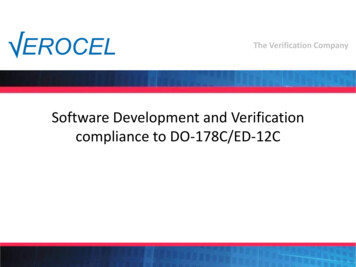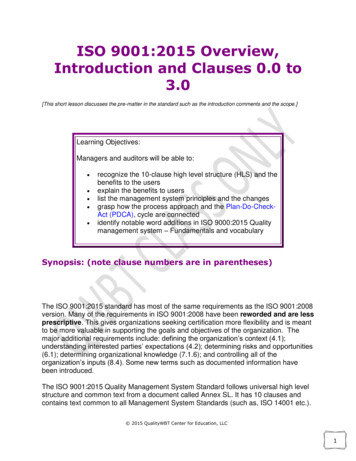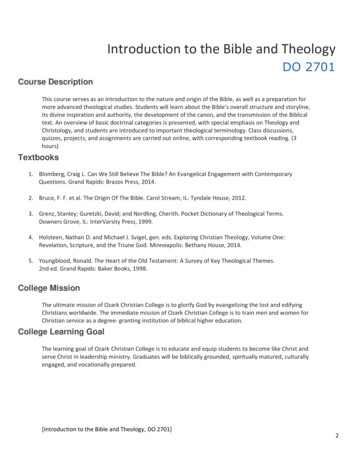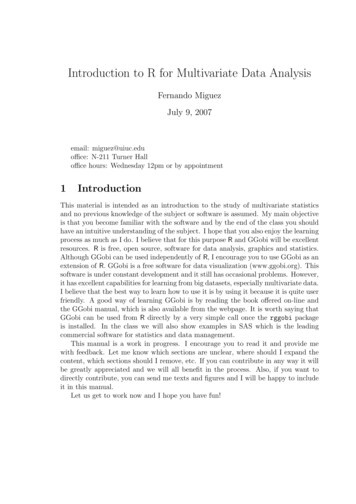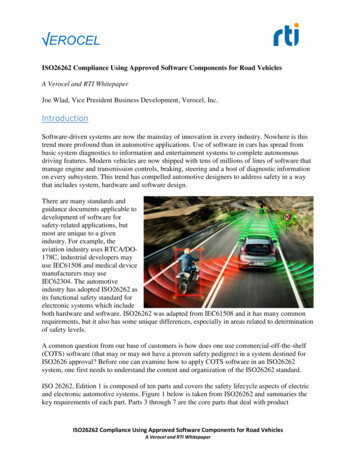
Transcription
ISO26262 Compliance Using Approved Software Components for Road VehiclesA Verocel and RTI WhitepaperJoe Wlad, Vice President Business Development, Verocel, Inc.IntroductionSoftware-driven systems are now the mainstay of innovation in every industry. Nowhere is thistrend more profound than in automotive applications. Use of software in cars has spread frombasic system diagnostics to information and entertainment systems to complete autonomousdriving features. Modern vehicles are now shipped with tens of millions of lines of software thatmanage engine and transmission controls, braking, steering and a host of diagnostic informationon every subsystem. This trend has compelled automotive designers to address safety in a waythat includes system, hardware and software design.There are many standards andguidance documents applicable todevelopment of software forsafety-related applications, butmost are unique to a givenindustry. For example, theaviation industry uses RTCA/DO178C, industrial developers mayuse IEC61508 and medical devicemanufacturers may useIEC62304. The automotiveindustry has adopted ISO26262 asits functional safety standard forelectronic systems which includeboth hardware and software. ISO26262 was adapted from IEC61508 and it has many commonrequirements, but it also has some unique differences, especially in areas related to determinationof safety levels.A common question from our base of customers is how does one use commercial-off-the-shelf(COTS) software (that may or may not have a proven safety pedigree) in a system destined forISO2626 approval? Before one can examine how to apply COTS software in an ISO26262system, one first needs to understand the content and organization of the ISO26262 standard.ISO 26262, Edition 1 is composed of ten parts and covers the safety lifecycle aspects of electricand electronic automotive systems. Figure 1 below is taken from ISO26262 and summaries thekey requirements of each part. Parts 3 through 7 are the core parts that deal with productISO26262 Compliance Using Approved Software Components for Road VehiclesA Verocel and RTI Whitepaper
development from the concept phase through design and production. An outline of the tensections is given below with brief description of what each part entails.1. Vocabulary2. Management of Functional Safety2-6 Safety Management DuringDevelopment2-5 Overall Safety Management3. Concept Phase3-5 Item Definition3-6 Initiation ofSafety Lifecycle3-7 Hazard Analysisand Risk Assessment3-8 Functional SafetyConcept2-7 Safety Management after release4. Product Development: System Level4-5 Initiation ofProduct Developmentat System Level4-6 Specification ofTechnical SafetyRequirements4-7 System Design5. Product Development:Hardware Level5-5 Initiation of ProductDevelopment at Hardware Level5-6 Specification of Hardware SafetyRequirements5-7 Hardware Design4-11 Release forProduction7. Production andOperation4-10 FunctionalSafety Assessment4-9 Safety Validation7-5 Production7-6 Operation,Service andDecommissioning4-8 Item Integrationand Testing6. Product Development:Software Level6-5 Initiation of ProductDevelopment at Software Level6-6 Specification of Sofware SafetyRequirements6-7 Software Arch. Design6-8 Software Unit Design5-8 Hardware Architectural Metrics5-9 Evaluation of Violation of SafetyGoal due to Random HW failures5-10 Hardware Integration andTesting6-9 Software Unit Test6-10 Software Integration andTesting6-11 Verification of Software SafetyRequirements8. Supporting Processes8-5 Interfaces within Distributed Environments8-10 Documentation8-6 Specification and Management of Safety Requirements8-11 Qualification of Software Tools8-7 Configuration Managements8-12 Qualification of Software Components8-8 Change Management8-9 Verification8-13 Qualification of Hardware Components8-14 Proven in Use Argument9. ASIL-oriented and Safety-oriented Analyses9-5 Requirements decomposition with respect to ASILTailoring9-7 Analysis of Dependent Failures9-6 Criteria for coexistence of elements9-8 Safety Analyses10. Guideline on ISO26262 (informative)Figure 1: ISO26262 Processes and Requirements (ref. ISO26262)ISO26262 Compliance Using Approved Software Components for Road VehiclesA Verocel and RTI Whitepaper
Part 1, Vocabulary: provides a definition and description of terms used in the standardPart 2, Management of Functional Safety: provides requirements and guidance on howthe organization and internal processes will be used during development and post-releasePart 3, Concept Phase: provides requirements and guidance for item definition,description of the safety lifecycle including the activities and the hazard analysis and riskassessmentPart 4, Product Development: System Level: provides requirements and guidance ondevelopment of system requirements, safety requirements, safety concept, system design,integration testing, safety validation, safety assessment and product releasePart 5, Product Development: Hardware Level: provides requirements and guidance forinitiation of hardware product development, hardware safety requirements, hardwaredesign which includes evaluation of hardware architectural metrics and potential safetygoal violations due to hardware failuresPart 6, Product Development: Software Level: provides requirements and guidance forinitiation of software product development, specification of software safety requirements,software design, unit implementation, unit testing, integration testing and verification ofsoftware safety requirementsPart 7, Production and Operation: provides requirements and guidance for developmentand maintenance of a production process for safety-related elements used in road vehiclesas well as achieving functional safety in the production processPart 8, Supporting Processes: provides guidance and requirements for overall safetymanagement, interfaces within distributed developments, configuration management,change management, verification, documentation, use of tools, qualification of hardwareand software components and proven-in-use argumentsPart 9, ASIL (Automotive Safety Integrity Level)-oriented and Safety-oriented Analyses:provides guidance and requirements for ASIL decomposition (system, hardware,software and across components) such that safety goals are inherited through safetyrequirements as well as failure analyses and safety analysesPart 10, Guideline (Informative): Provides readers the key concepts of ISO26262,differences with IEC61508 and additional details on ASIL decomposition, safety cases,hazard analyses and risk assessmentsEach subsection of ISO26262 is formatted in a similar way. The document provides a list ofobjectives for each general requirement (e.g. initiation of product development at the softwarelevel), inputs (e.g., safety plan), requirements (e.g., activities for product development at thesoftware level shall be planned) and work products (e.g., software verification plan). From aholistic point of view all the sections of ISO26262 must be addressed (at the appropriateAutomotive Safety Integrity Level) to be considered compliant. The high-level steps tocompliance will include creation and approval of a safety plan, safety goals and safety case alongwith a complete safety lifecycle with bi-directional traceability. The activities and work productswill include verification, validation, independent assessment (by an accredited agency) and acomplete list of documentation supporting the required activities.ISO26262 Compliance Using Approved Software Components for Road VehiclesA Verocel and RTI Whitepaper
Additionally, the structure of ISO26262 is encapsulated in a way that permits activities,validation and assessment for each major part of development to take place independently.Therefore, one conceivably can take a hardware or software component, assess and approve it inone system or element and then reuse the approval in other systems and assessments. In fact, part8-12 and 8-13 of ISO 26262 directly address requirements for approval of software and hardwarecomponents, respectively.ISO 26262, Part 6: Software RequirementsAs stated earlier, part 6 is a core process requirement of ISO26262 and as such does not includesupporting processes of functional safety managements, configuration management and changemanagement and more. The part 6 requirements are specified in a waterfall model ofdevelopment and verification. While ISO26262 does not assume any particular model ofsoftware development (agile, iterative, etc.,) it is convenient to document requirements in way asif the software were designed in a waterfall model. In fact, other software certification guidanceand standards such as DO-178C and IECE61508 are written in a similar manner. The firstrequirement in developing software to be compliant with ISO26262 is to initiate a safety planand software verification plan. These plans would of course be supported by other process plans(defined in parts 2 and 8 of ISO 26262).Once the initiation activities are complete, the specification of software safety requirementsprocess takes place. Here there is an inexorable link to the safety concept and overall systemdesign. The system design and/or hardware design will place limitations and burdens on softwareand these constraints need to be considered as part of the requirements process. A good candidatefor a software component approved under ISO26262 would likely have a well-defined andexposed interface into any system or hardware design. This does not mean that any system orhardware would support a given software component but that any limitations or conditions beexposed to an integrator (for example, memory and CPU constraints would be specificrequirements if needed). The work products resulting from this phase include a softwarerequirements specification, refined hardware-software interface specification and results of thesoftware verification activities.The software architectural design process defines the requirements that permit the software to bewritten without ambiguity. The design may be specified in a number of ways (formally or semiformally) and ISO26262 has recommendations on what notations should be used depending onthe required ASIL. Additionally, ISO26262 specifies properties of software design that areconducive to safety elements (such as restrictions on size and complexity). If the design processemploys partitioning of software components, then additional requirements are imposed todemonstrate that freedom from interference is preserved. The methods for verification of thesoftware design varies by ASIL but for the higher criticalities, design walkthroughs, inspectionsand control and data flow analyses are either recommended or highly recommended. The workproducts resulting from the design process are a software design specification, failure analysisreport (if partitioning is used) and documented verification results.ISO26262 Compliance Using Approved Software Components for Road VehiclesA Verocel and RTI Whitepaper
The software unit design and implementation phase is commonly known as the coding phase,where the software requirements and design information are used to produce software modules.Requirements for the coding phase include having consistent interfaces, a robust implementation,verifiability and testability, among others. ISO26262 requires that the implementation dependson design detail that is sufficient to write each module or function. In other words, if low-levelrequirements or design information is not uniquely traceable to software functions, a compliancegap may exist. The properties of the implementation required by ISO26262 include norecursions, limited use of pointers, no unconditional jumps and more. The verification activitiesfor software implementation include static code analysis, compliance with coding standards,control flow analysis and data flow analysis and compliance (including traceability) with statedrequirements and design data. The outputs of this phase include verification results andcompleted software implementation.The software unit testing phase may appear to some to be misleading in the sense that it’s simplystructural unit testing of individual software modules. ISO26262 requires that the testing includeverification of proper implementation of requirements and design and therefore the test casesshould be created directly from the requirements and not from the implementation. Additionally,the unit test phase should demonstrate that no unintended behavior exists in the implementationand that the implementation is robust (e.g., can respond gracefully to abnormal input conditions).Completeness and absence of unintended behavior is demonstrated by showing the requiredcoverage for the associated ASIL (e.g., statement, decision or modified condition/decisioncoverage). The outputs of this phase includes a verification report demonstrating the test resultsare correct, complete and produced the required coverage.The software integration and testing phase is intended to demonstrate that software elements (orcomponents) verified in the software unit testing phase can be fully integrated and completelytested. The integration phase may involve both safety and non-safety related elements.Integration testing will demonstrate correctness of the hardware-software interface as well asverify compliance with the software architectural design. Integration testing includesrequirements-based tests, integration tests, fault-injection tests, resource usage tests (stack, heapand execution times among others) and ideally should be performed on the actual targethardware of the software application or applications. The metrics that apply to integration testingare function coverage and call coverage. The functional and call coverage tests may revealsoftware that is not exercised and in these cases, the software should be removed or otherwisedeclared as deactivated. An analysis of deactivated code should be done to confirm that presenceof the deactivated code does not impair operation of the verified software. It is assumed that thedeactivated code is not dead code in the sense that it has no traceability to requirements since theunit testing phase should expose any dead code. The outputs of this phase are the completeintegrated software and the verification report confirming successful completion of theintegration testing objectives.The verification of software safety requirements is the last stage of software verification inISO26262. This stage is used to confirm the software requirements are met in the actual targetenvironment. Up to this point, testing and verification may take place on simulated hardware orISO26262 Compliance Using Approved Software Components for Road VehiclesA Verocel and RTI Whitepaper
reference hardware not intended to be used in the actual production vehicle. The testenvironment at this stage may be the actual vehicle, integration test bench, or networkenvironments that replicate the actual vehicle architecture related to the software under test. Theoutputs of this phase is the verification report confirming successful completion of the testingobjectives in the actual hardware environment.COTS Approach to Satisfy Part 6 RequirementsThe organization of ISO26262 Part 6 and other ISO parts are highly conducive to approval,assessment and reuse of COTS software components intended to be used in a variety ofapplications. First, the organization of the software lifecycle requirements and activities in part 6are staged, meaning that the outputs of one phase are the inputs to the next. There are 3 levels ofsoftware testing defined in part 6 and each of these testing is the result of increased softwareintegration. For example, a software component developer may test a component such as adistributed data service or software bus on reference hardware that may later be integrated intoan automotive control system. In this case the software component developer would satisfy asubset of the requirements in part 6 (as well as other parts) and leave the remaining complianceobjectives to the integrator.The other parts of ISO26262 that are relevant to software components include part 2(Management of Functional Safety) and part 8 (Supporting Processes). The software componentdeveloper would need to demonstrate that its internal planning processes are aligned with part 2requirements. At a minimum this would include a functional safety management plan and aquality management plan as well as evidence of a safety culture and personnel who are trainedand responsible for enforcing the safety culture in both the development and production phases.Additional plans that would be required (and defined in the safety plan or quality plan) are theverification plan, validation plan and test plans that demonstrate adherence to ISO26262requirements. Once a supplier can support the requirements of part 2, they have a framework toensure their software developed under part 2 requirements can support the other parts ofISO26262.ISO26262 Compliance Using Approved Software Components for Road VehiclesA Verocel and RTI Whitepaper
The planning processwill also includereferences to anyapplicable toolqualification plans.This could includesoftware modellingtools, coverageanalysis tools and anyother tools used in thedevelopment orverification activities.ISO26262 part 8 isrelevant for softwarecomponent suppliers.Part 8 definesrequirements fordocumentationcontrol, configuration management, change management and requirements for qualification oftools used under ISO26262. Clause 12 of part 8 defines the requirements for qualification ofsoftware components, thereby making explicit the notion that approval of software componentsunder ISO26262 is possible.The requirements to qualify a software component under clause 12 of part 8 include: Requirements that address functionality, resource usage, response times, behavior underfailure conditions and robustnessDescription of the configuration, interfaces and how to integrate the component,description of operation under abnormal conditions and a description of knownlimitations and workarounds (to include both existing defects and limitations)Verification results showing full coverage of all applicable software requirements,including robustness for normal and abnormal conditions and including the requiredstructural coverage analysis applicable to the proposed ASILDocumentation of the software identification and configuration, targeted ASIL, hardwarecompatibility limitations, organization performing the qualification and the results of theverification measures applied to the software componentThe qualification results and the validity of the results must be verified and if requiredadditional activities may need to be performedThe last point above becomes a key factor in determining the value of software component reusein ISO26262. Establishing the validity of the qualification results in a different environment willalways compel some additional activities on the part of the integrator. If the supplied softwareISO26262 Compliance Using Approved Software Components for Road VehiclesA Verocel and RTI Whitepaper
component does not adequately document the scope of usage, approval and limitations, theintegrator may be challenged in trying to apply ISO26262 credit for the component in theirrespective environment. Additional information on considerations for using qualified softwarecomponents is presented below.RTI Connext DDS Micro as an ISO26262 Qualified Software ComponentReal-time Innovations, Inc. (RTI) has a certifiable version of its Connext DDS product that iswidely used in mission and safety critical applications. Connext DDS provides softwaredevelopers and integrators with high-level interfaces for distributing real-time data betweendevices, applications and subsystems. For example, Connext DDS can be used to stream video,radar and LIDAR data to analytics and autonomous driving applications as well as to integratethose applications with traditional ECUs. Connext DDS is often referred to as “communicationsmiddleware” since it is a library that sits between applications and the underlying operatingsystem and network stack, providing developers with high-level publish/subscribe interfaces thatabstract low-level networking details.Connext DDS Cert supports the DDS (Data Distribution Service) family of standards and is acertifiable middleware available with a complete, commercially supported certification packageto support ISO26262 certification, including ASIL-D. The package includes all of the evidencerequired by a certification authority such as TÜV SÜD.Using certified middleware that is conforms to a widely used industry standard has a number ofimportant benefitsISO26262 Compliance Using Approved Software Components for Road VehiclesA Verocel and RTI Whitepaper
Significant cost savings; by significantly reducing the amount of custom communicationsand integration logic required, Connext DDS Cert can save tens or even hundreds ofthousands of lines of code, avoiding potentially millions of dollars in certification cost.Reduced risk; to develop safety software a stringent set of procedures must be followedmaking the software expensive and risky to develop, or redevelop, if these proceduresweren’t followed in the original development.Leverage experience; RTI has used DDS in many mission and safety critical industries,the software, DDS standard, and certification package are developed based on deeparchitecture experience from these 1000 projects.Reliability; a new standard or custom development effort does not have the years ofproject experience and in-field deployments that demonstrates reliability over the longterm.Interoperability; DDS is supported by a number of vendors and interoperability is ensuredwith frequent testing against the standard and between the leading vendors.Open Architecture; Connext DDS aligns with many open architecture initiativesincluding the Future Airborne Capability Environment (FACE), UAS Control Segment(UCS) Architecture, and Open Mission Systems (OMS).Component Isolation; perhaps the most important benefit of certified middleware, acommunications framework certified to the highest safety standard will isolate thevarious software component of a system and allow them to be certified to different safetylevels, even when they communicate or share information between them.Certified middleware can continue to return costs savings through the entire product life-cycle.After the initial costs savings in development and certification, the combination of componentisolation and the loose-coupling of applications can reduce maintenance cost and life-cycledevelopment costs by allowing upgrades and re-certification of individual components withoutre-certifying unmodified portions of a system. These costs savings can dwarf the originalcertification cost over the life of the product and can be an important differentiator of anysoftware system.In the Automotive market, this especially applies to in-car advanced driver assistance system(ADAS) and Autonomous Drive applications where multiple software components must sharedata. In a well architected system these interdependent systems should be loosely coupled andwill need varying levels of certification, depending on their function. For example, a sense-andavoid braking system would likely need certification to ASIL-D and any software critical to thesensing, decision making, and resulting action would need this certification (i.e. sensors, ECUs,software algorithms, braking, and steering modules). However, functions like navigation andpath planning may need to interact with some of the same components but would likely need amuch lower certification level or no certification at all. Without certified middleware to isolateand separate these functions, every component would need to be certified to the highestcertification, which would be very expensive and would limit the possible features and functionsof a system.ISO26262 Compliance Using Approved Software Components for Road VehiclesA Verocel and RTI Whitepaper
Considerations for Using ISO26262 Qualified Software ComponentsAs stated above, ISO26262 part 8, clause 12 addresses the requirements for software reuse.Reuse could apply to a vendor’s own software or COTS software procured from a third party.Use of COTS components create some obstacles for integrators when trying to approve thesecomponents due to lack of familiarity, use of different standards and plans and likely differentverification methods and tools. Even though the COTS supplier can provide the requireddocumentation and data to substantiate ISO26262 compliance, the integrator is still responsiblefor obtaining ultimate approval for its use. In Verocel’s experience, software components for usein ISO26262-approved systems should have the following characteristics: Have few, if any hardware dependenciesBe easily portable to varying hardware platformsHave clear boundaries with other software components and hardwareBe provided in binary or pre-linked form, obviating the need for rebuildingBe of limited complexityBe adaptable for modification and expansion with minimal change impactThe characteristics defined above offer both economic, technical and certification value to boththe supplier and user. It is expected that any approved software component will be used in avariety of applications or it would not be of much use to an integrator. Examples of goodreusable software components are operating systems, communication and messaging software(such as RTI Connext DDS Cert), language and graphics libraries and file system interfaces,among others. Verocel has performed certification activities to each of these softwarecomponents for various customers across aerospace, industrial and medical industries.Verocel has learned that by providing guidance on how to use and apply the software componentand its certification data into a variety of applications, the integrator’s certification burden andrisk can be minimized. A software component approved under ISO26262 should include thefollowing data and information so the integrator can maximize their familiarity with thecomponent and represent it more easily when submitted for ISO26262 approval. ISO26262 Compliance Certificate from an approved entity (such as TüV).Software Safety Plan: The safety plan defines the software component and provides anoverview of the compliance sought. It also initiates the software planning process andprovides an overview of each lifecycle stage, the inputs, activities and outputs of eachstage.Functional Safety Manual: this document provides a summary of the softwarecomponent, its characteristics, configuration and pedigree of approval under ISO26262(including maximum ASIL usage). Additionally, it should include a list of openproblems, a list of hazards or vulnerabilities and a summary of workarounds for thoseproblems and vulnerabilities.ISO26262 Compliance Using Approved Software Components for Road VehiclesA Verocel and RTI Whitepaper
Compliance Matrix (may be part of the safety manual): This matrix shows the Part 2, 6and part 8 objectives that the software component fulfils. The matrix summaries eachrequirement, the associated evidence of compliance and to what extent credit is taken foreach objective. For any objectives where full credit is not taken, a summary of therequired activities by the integrator should be included.Configuration Index or Version Description Document: Provides an unambiguous reporton the exact configuration of the software component (source and binary) includingconfiguration of any associated build tools, environment and all documentationassociated with the approved component. Methods of how to ensure binary identicality ofthe software component in the user’s environment should be provided.User’s Guides and Manuals: If not provided as part of the safety manual, guides andmanuals should be provided describing how to install, operate and used the software.Included would be description of the interfaces along with any limitations on use of thoseinterfaces.Verification Results: The verification results would include information on reviews ofrequirements, design and code, test cases and results. Also included are the test resultsand coverage analysis for the software component.Test Vectors: The supplier should be furnished with a copy of the test vectors so they canrepeat the test cases in their environment as a means to establish equivalence to theresults supplied by the component developer.Tool Qualification Data and Results: Documents showing the tool qualification plan, toolqualification level and qualification results should be included, especially if the integratorneeds to make use of these tools in their environment.Vulnerability Analysis or Hazard Analysis: This document would provide details on thehazards and vulnerabilities summarized in the safety manual. This information will givethe integrator additional insight into the rationale behind each hazard and mitigationtechnique. This information will assist the developer in composing their safety analysis atboth the system and hardware levels.Traceability Data: This information shows direct linkages between requirements, design,code, test cases and results as well as traceability to reviews of each activity includingchange management of each lifecycle data item.Partitioning Analysis (optional): A partitioning analysis may be required if the softwarecomponent supports some level of ASIL separation (such as an operating environment).The partitioning analysis will show the integrator how isolation is preserved shouldcomponents at a lower level of ASIL fail. The partitioning analysis will include someassumptions and perhaps limitations if there are dependencies on the hardware or ahardware-software interfaceIntegration Guide: If not already
8-12 and 8-13 of ISO 26262 directly address requirements for approval of software and hardware components, respectively. ISO 26262, Part 6: Software Requirements As stated earlier, part 6 is a core process requirement of ISO26262 and as such does not include supporting processes of functional safety managements, configuration management and change
